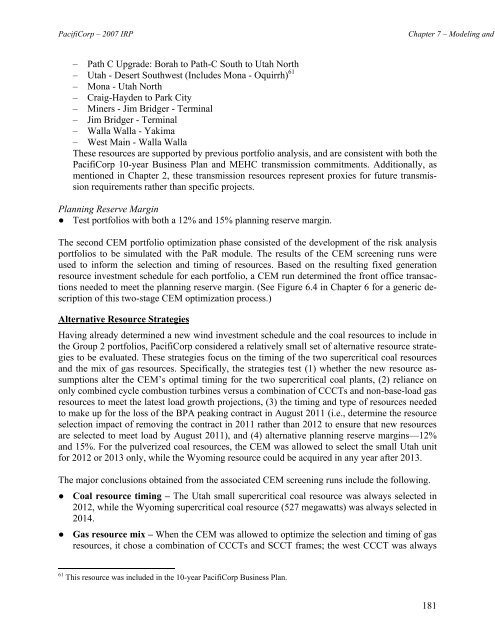PacifiCorp 2007 Integrated Resource Plan (May 30, 2007)
PacifiCorp 2007 Integrated Resource Plan (May 30, 2007)
PacifiCorp 2007 Integrated Resource Plan (May 30, 2007)
Create successful ePaper yourself
Turn your PDF publications into a flip-book with our unique Google optimized e-Paper software.
<strong>PacifiCorp</strong> – <strong>2007</strong> IRPChapter 7 – Modeling and– Path C Upgrade: Borah to Path-C South to Utah North– Utah - Desert Southwest (Includes Mona - Oquirrh) 61– Mona - Utah North– Craig-Hayden to Park City– Miners - Jim Bridger - Terminal– Jim Bridger - Terminal– Walla Walla - Yakima– West Main - Walla WallaThese resources are supported by previous portfolio analysis, and are consistent with both the<strong>PacifiCorp</strong> 10-year Business <strong>Plan</strong> and MEHC transmission commitments. Additionally, asmentioned in Chapter 2, these transmission resources represent proxies for future transmissionrequirements rather than specific projects.<strong>Plan</strong>ning Reserve Margin● Test portfolios with both a 12% and 15% planning reserve margin.The second CEM portfolio optimization phase consisted of the development of the risk analysisportfolios to be simulated with the PaR module. The results of the CEM screening runs wereused to inform the selection and timing of resources. Based on the resulting fixed generationresource investment schedule for each portfolio, a CEM run determined the front office transactionsneeded to meet the planning reserve margin. (See Figure 6.4 in Chapter 6 for a generic descriptionof this two-stage CEM optimization process.)Alternative <strong>Resource</strong> StrategiesHaving already determined a new wind investment schedule and the coal resources to include inthe Group 2 portfolios, <strong>PacifiCorp</strong> considered a relatively small set of alternative resource strategiesto be evaluated. These strategies focus on the timing of the two supercritical coal resourcesand the mix of gas resources. Specifically, the strategies test (1) whether the new resource assumptionsalter the CEM’s optimal timing for the two supercritical coal plants, (2) reliance ononly combined cycle combustion turbines versus a combination of CCCTs and non-base-load gasresources to meet the latest load growth projections, (3) the timing and type of resources neededto make up for the loss of the BPA peaking contract in August 2011 (i.e., determine the resourceselection impact of removing the contract in 2011 rather than 2012 to ensure that new resourcesare selected to meet load by August 2011), and (4) alternative planning reserve margins—12%and 15%. For the pulverized coal resources, the CEM was allowed to select the small Utah unitfor 2012 or 2013 only, while the Wyoming resource could be acquired in any year after 2013.The major conclusions obtained from the associated CEM screening runs include the following.● Coal resource timing – The Utah small supercritical coal resource was always selected in2012, while the Wyoming supercritical coal resource (527 megawatts) was always selected in2014.● Gas resource mix – When the CEM was allowed to optimize the selection and timing of gasresources, it chose a combination of CCCTs and SCCT frames; the west CCCT was always61 This resource was included in the 10-year <strong>PacifiCorp</strong> Business <strong>Plan</strong>.181
















